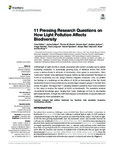11 pressing research questions on how light pollution affects biodiversity
| dc.contributor.author | Holker, F | |
| dc.contributor.author | Bolliger, J | |
| dc.contributor.author | Davies, Thomas | |
| dc.contributor.author | Giavi, S | |
| dc.contributor.author | Jechow, A | |
| dc.contributor.author | Kalinkat, G | |
| dc.contributor.author | Longcore, T | |
| dc.contributor.author | Spoelstra, K | |
| dc.contributor.author | Tidau, Svenja | |
| dc.contributor.author | Visser, M | |
| dc.contributor.author | Knopp, E | |
| dc.date.accessioned | 2021-11-18T09:11:41Z | |
| dc.date.issued | 2021-12-08 | |
| dc.identifier.issn | 2296-701X | |
| dc.identifier.issn | 2296-701X | |
| dc.identifier.other | ARTN 767177 | |
| dc.identifier.uri | http://hdl.handle.net/10026.1/18391 | |
| dc.description.abstract |
<jats:p>Artificial light at night (ALAN) is closely associated with modern societies and is rapidly increasing worldwide. A dynamically growing body of literature shows that ALAN poses a serious threat to all levels of biodiversity—from genes to ecosystems. Many “unknowns” remain to be addressed however, before we fully understand the impact of ALAN on biodiversity and can design effective mitigation measures. Here, we distilled the findings of a workshop on the effects of ALAN on biodiversity at the first World Biodiversity Forum in Davos attended by several major research groups in the field from across the globe. We argue that 11 pressing research questions have to be answered to find ways to reduce the impact of ALAN on biodiversity. The questions address fundamental knowledge gaps, ranging from basic challenges on how to standardize light measurements, through the multi-level impacts on biodiversity, to opportunities and challenges for more sustainable use.</jats:p> | |
| dc.format.extent | 767177- | |
| dc.language.iso | en | |
| dc.publisher | Frontiers Media | |
| dc.subject | ecological light pollution | |
| dc.subject | biodiversity loss | |
| dc.subject | thresholds | |
| dc.subject | traits | |
| dc.subject | populations | |
| dc.subject | ecosystems | |
| dc.subject | interdisciplinary | |
| dc.subject | mitigation | |
| dc.title | 11 pressing research questions on how light pollution affects biodiversity | |
| dc.type | journal-article | |
| dc.type | Review | |
| dc.type | Journal | |
| plymouth.author-url | https://www.webofscience.com/api/gateway?GWVersion=2&SrcApp=PARTNER_APP&SrcAuth=LinksAMR&KeyUT=WOS:000738175900001&DestLinkType=FullRecord&DestApp=ALL_WOS&UsrCustomerID=11bb513d99f797142bcfeffcc58ea008 | |
| plymouth.volume | 9 | |
| plymouth.publication-status | Published online | |
| plymouth.journal | Frontiers in Ecology and Evolution | |
| dc.identifier.doi | 10.3389/fevo.2021.767177 | |
| plymouth.organisational-group | /Plymouth | |
| plymouth.organisational-group | /Plymouth/Faculty of Science and Engineering | |
| plymouth.organisational-group | /Plymouth/Faculty of Science and Engineering/School of Biological and Marine Sciences | |
| plymouth.organisational-group | /Plymouth/REF 2021 Researchers by UoA | |
| plymouth.organisational-group | /Plymouth/REF 2021 Researchers by UoA/UoA07 Earth Systems and Environmental Sciences | |
| plymouth.organisational-group | /Plymouth/Users by role | |
| plymouth.organisational-group | /Plymouth/Users by role/Academics | |
| plymouth.organisational-group | /Plymouth/Users by role/Researchers in ResearchFish submission | |
| dcterms.dateAccepted | 2021-11-17 | |
| dc.rights.embargodate | 2021-12-9 | |
| dc.identifier.eissn | 2296-701X | |
| dc.rights.embargoperiod | Not known | |
| rioxxterms.versionofrecord | 10.3389/fevo.2021.767177 | |
| rioxxterms.licenseref.uri | http://www.rioxx.net/licenses/all-rights-reserved | |
| rioxxterms.licenseref.startdate | 2021-12-08 | |
| rioxxterms.type | Journal Article/Review | |
| plymouth.funder | Artificial Light Impacts on Coastal Ecosystems (ALICE)::Natural Environment Research Council [2006-2012] |


